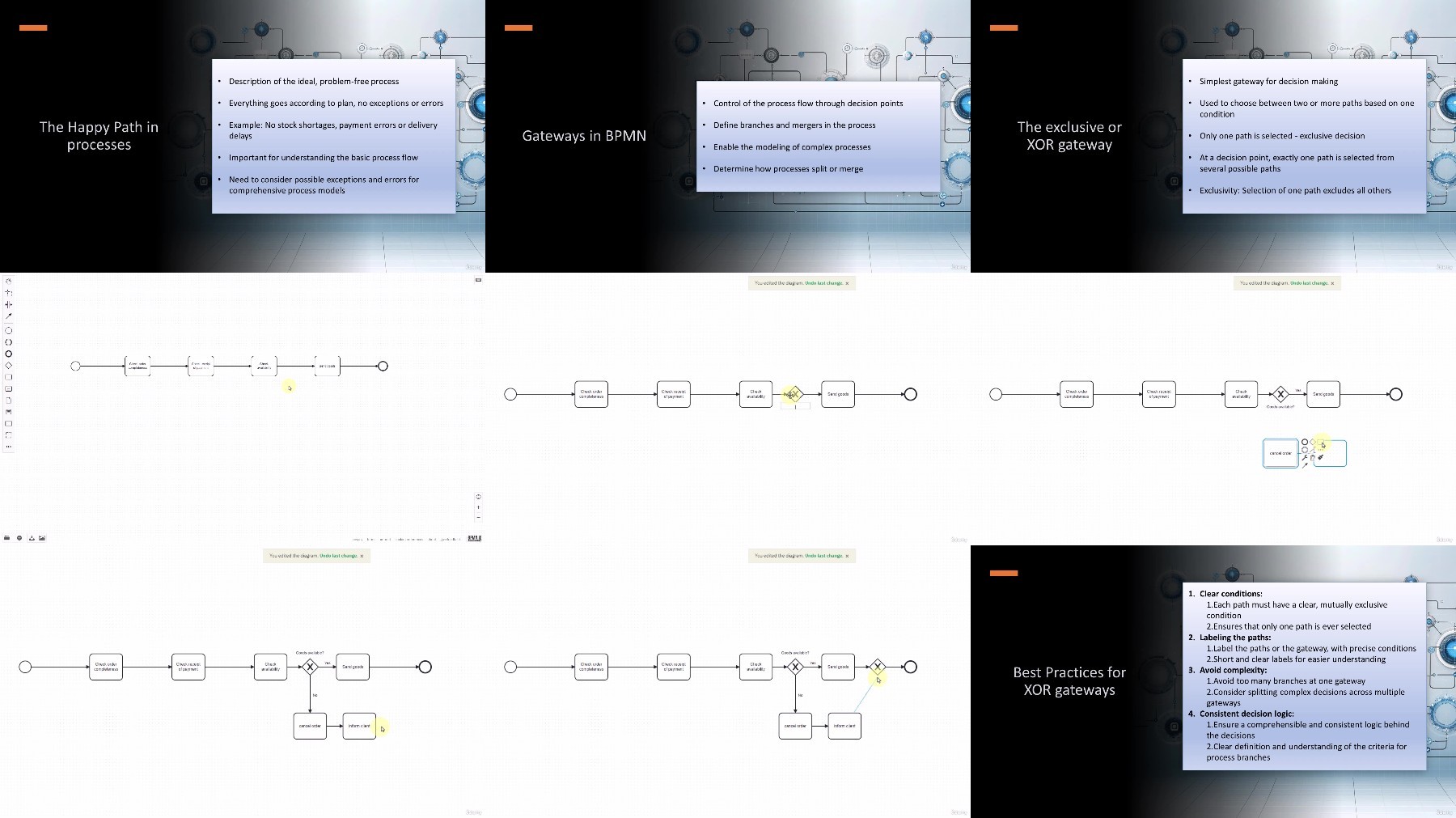
Bpmn 2.0 - Become A Professional Process Designer
Published 3/2024
MP4 | Video: h264, 1920x1080 | Audio: AAC, 44.1 KHz
Language: English
| Duration: 4h 4m
For beginners and advanced users: Effective business process modeling with BPMN 2.0
What you'll learn
Correct use of all BPMN symbols in diagrams
Design effective pools and swimlanes to represent different actors in processes
Use of gateways to control process flows and decision points
Creation of end-to-end process flows using start and end events
Use of sub-processes to simplify complex business processes
Use of data objects and artifacts to refine process diagrams
Use of message flows to represent communication between processes
Integration of event-based gateways for dynamic process decisions
Use of intermediate and boundary events
Requirements
No previous knowledge necessary. You will learn everything you need to know
Description
This course is carefully designed to take you from the basics of business process modeling through to advanced techniques and help you become an expert in the use of the BPMN 2.0 specification.Starting with an introduction to the meaning and application of business process modeling, you will be quickly introduced to the world of BPMN. We cover all the basic symbols, elements and diagram types you need to model your first processes. You will learn how to effectively use start and end events, tasks, gateways and sub-processes to create clear and understandable process diagrams.Once the basics are mastered, the course introduces you to advanced modeling techniques. You will explore complex workflows, multiple instances, event-driven processes and the use of artifacts to enrich your diagrams with additional information and increase their comprehensibility.Sounds worse than it is. I will explain everything in detail and in an understandable way.The section on events will show you how to effectively use different types of events such as timers, messages and errors to model realistic and dynamic business processes. In the Gateways section, you will learn how to properly represent decision points in your processes and control different path options based on business rules.In addition to technical skills, the course emphasizes best practices and developing a deep understanding of how BPMN 2.0 can be applied in real-world business scenarios. You will learn how to design efficient, flexible and scalable business processes that meet the needs of your organization.This course is perfect for beginners who have no prior knowledge of BPMN as well as advanced learners who want to deepen their knowledge.
Overview
Section 1: Introduction to Business Process Modeling
Lecture 1 What you will learn in this course
Lecture 2 Why process modeling can boost your career
Lecture 3 What is a business process? Definition & examples
Lecture 4 Why business process modeling is essential
Lecture 5 BPMN 2.0: More than just modeling
Lecture 6 BPMN: From its origins to its significance today
Lecture 7 The right choice: choosing BPMN tools effectively
Lecture 8 Where we stand and what happens next
Section 2: BPMN Fundamentals - Designing a simple process
Lecture 9 Introduction to bpmn.io: Our BPMN Tool of Choice
Lecture 10 Introduction to the simple start event in BPMN
Lecture 11 Discover the basics of BPMN tasks
Lecture 12 Sequence flows and tokens in BPMN: clearly explained
Lecture 13 Alternative process flows - introduction to XOR Gateways
Lecture 14 Subprocesses: Structure and clarity
Lecture 15 Solving the quiz: Mastering sub-processes in BPMN
Section 3: Advanced modeling techniques
Lecture 16 Pools and lanes in BPMN: meaning
Lecture 17 Pools & Message Flows: Effective process communication
Lecture 18 Message start event: Message flows control the start of the process
Lecture 19 Camunda Token-Simulation in Action
Lecture 20 Live: Token simulation
Lecture 21 Optimizing our BPMN process: identifying and solving problems
Lecture 22 Intermediate Events in BPMN: Throw & Catch
Lecture 23 Some final words on this section
Section 4: Expert know-how - Events
Lecture 24 Introduction to BPMN events
Lecture 25 Timer events: time control in processes
Lecture 26 Conditional events: Automated process control
Lecture 27 Message Events: Applications & Meaning
Lecture 28 Signal events: Broadcast-style communication
Lecture 29 Understanding boundary events in BPMN
Lecture 30 Event sub-processes - Event-driven sub-processes
Lecture 31 Escalation events - How to deal with escalations in BPMN
Lecture 32 Compensation events - corrections elegantly resolved
Lecture 33 The termination event - emergency stop in the process
Lecture 34 Error events - error handling with BPMN
Lecture 35 Transaction Subprocesses & Cancel Events: All in one
Lecture 36 Link events: Bridges in your BPMN diagrams
Lecture 37 Last words on the BPMN events
Section 5: Expert know-how - Gateways
Lecture 38 Introduction to gateways in BPMN
Lecture 39 Exclusive Gateway: Decisions control the process
Lecture 40 Parallel Gateway: Efficiency boost for business processes
Lecture 41 Inclusive gateway: More flexibility in the process flow
Lecture 42 Event-based gateways: Controlling the process flow with events
Lecture 43 Complex gateway: A necessary evil?
Lecture 44 Last words on the gateways in BPMN
Section 6: Expert know-how - Activities
Lecture 45 Introduction to the BPMN activity types
Lecture 46 Receive Tasks: Waiting for input
Lecture 47 Send Tasks: Deep Dive
Lecture 48 Multi-instancing and loops: Simplify your BMPN diagrams
Lecture 49 Manual Task: Manual work in BPMN
Lecture 50 User Tasks: Human interaction meets IT
Lecture 51 Service Tasks: Understanding and applying automation
Lecture 52 Script Tasks: Automation without external dependencies
Lecture 53 Business Rule Task: Outsourcing complex decisions
Lecture 54 Call activities: Global sub-processes
Lecture 55 Ad-hoc sub-processes: When it comes to flexibility
Lecture 56 Activity types: Last words
Section 7: Expert know-how - Artefacts
Lecture 57 Artifacts in BPMN: An introduction
Lecture 58 Text annotations: Your BPMN notepad
Lecture 59 Data Objects: About the data within business processes
Lecture 60 Data Store References: Persistent data across process boundaries
Lecture 61 Groups: Your virtual garden fence
Lecture 62 Artifacts in BPMN: Last words
Section 8: Process Modeling - Best Practice
Lecture 63 Introduction to BPMN Best Practices
Lecture 64 Camunda Modeler & Token Simulator: Download & Installation
Lecture 65 Token Simulator: More than just a toy
Lecture 66 Labeling: How to make your BPMN model understandable!
Lecture 67 Symmetry in BPMN: The key to clear process diagrams
Lecture 68 Iterating towards a clear process model
Lecture 69 Color management in BPMN designs
Section 9: Conclusion
Lecture 70 A few final words and thanks
Interested beginners,Advanced,Business Analysts,Project managers,Anyone who has always wanted to learn BPMN




Bpmn 2 0 - Become A Professional Process Designer
